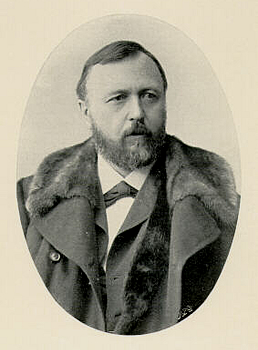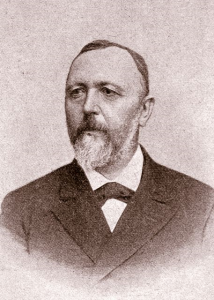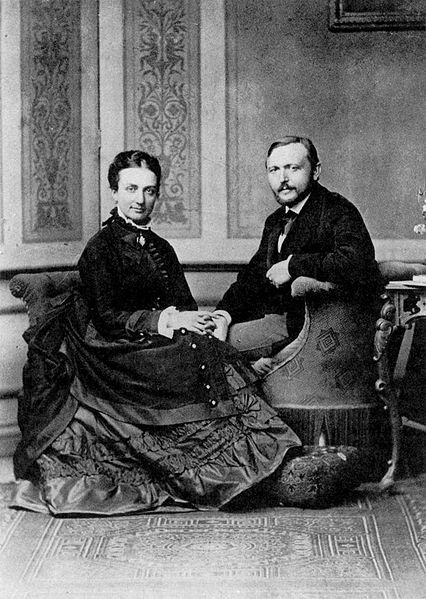<Back to Index>
- Psychiatrist Richard von Krafft - Ebing, 1840
- Writer Ernest Thompson Seton, 1860
- Emperor of Japan Hanazono, 1297
PAGE SPONSOR



Richard Freiherr von Krafft - Ebing (14 August 1840 – 22 December 1902) was an Austro – German sexologist and psychiatrist born in Mannheim, Baden, Germany. He studied medicine at the University of Heidelberg, specialized in psychiatry, and then worked in psychiatric asylums. Upon becoming disappointed with the workings of psychiatric hospitals, he pursued an academic career as a professor, a public lecturer on psychiatry, hypnotist, and a forensic expert at Strasbourg, Graz, and Vienna, the Austro - Hungarian capital.
The principal work of Dr. von Krafft - Ebing, Psychopathia Sexualis: eine Klinisch - Forensische Studie (1886) is a series of sexual case histories of the varieties of human sexual behaviour. It popularized the terms sadism, derived from the brutal sexual practices depicted in the novels of the Marquis de Sade; and masochism, derived from the surname of Leopold von Sacher - Masoch, whose novel Venus in Furs (1870) features a protagonist who requires flogging and sexual enslavement by a beautiful woman, and early uses of the terms homosexual and heterosexual. As a psychiatrist, Dr. Richard von Krafft - Ebing wrote Psychopathia Sexualis: eine Klinisch - Forensische Studie (Sexual Psychopathy: a Clinical - Forensic Study,
1886) as a forensic reference book for physicians and judges; written
in high academic style, the introduction noted he had "deliberately
chosen a scientific term for the name of the book, to discourage lay
readers", likewise did he write "sections of the book in Latin for the
same purpose." Sexual Psychopathy was one of the first books about sexual practices that studied homosexuality; the clitoral orgasm and jouissance,
the sexual pleasure of the woman; and proposed consideration of the
mental state of sexual criminals in the legal judgement of their
actions. As such, it was the medico – legal textual authority on
psychosexual diversity, and a most influential human sexuality book
until Sigmund Freud published his works. The first edition of Psychopathia Sexualis (1886) presents four categories of "cerebral neuroses": As
an Austrian man of his time and Roman Catholic culture, Richard von
Krafft - Ebing believed that procreation was the purpose of sexual desire,
and that any form of recreational sexual intercourse was a perversion of the sex drive. He perceived women as sexually passive, and thus recorded no sexual case studies of sadistic or fetishistic women. Furthermore, in the case of a woman practicant of masculine masochism,
he classified her behaviour as "sexual bondage", which was not a
perversion, because it did not prevent pregnancy. Moreover, among
Krafft - Ebing's few case studies of women was that of Count Sandor Vay, a
female - to - male transsexual.
Krafft - Ebing recorded his physical particulars and theorized that Vay’s
mannish appearance might indicate a genetic cause for transsexuality: Given procreation as the purpose of sexual intercourse, Krafft - Ebing concluded that homosexuals did suffer a degree of sexual perversion, because such copulation was contrary to its procreational purpose. In some cases, homosexual libido was classified as a moral vice induced by early practice of masturbation. He proposed a theory of homosexuality as biologically anomalous, originated in the embrionic and fetal stages of gestation, that evolved into a "sexual inversion" of the brain. In 1901, in an article in the Jahrbuch für sexuelle Zwischenstufen (Yearbook of Sexual Intermediate Stages), he changed the biological term from anomaly to differentiation. Nonetheless, Krafft - Ebing’s conclusions remained forgotten, partly because Sigmund Freud’s
theories were more interesting to physicians who considered
homosexuality a "psychological problem", and partly because he had
incurred the enmity of the Austrian Roman Catholic Church by
psychologically associating martyrdom (desire for sanctity) with hysteria and masochism. Moreover, in a footnote added to the 1915 edition of Three Essays on the Theory of Sexuality (1905), Sigmund Freud urged that homosexuals not be segregated from mainstream society.